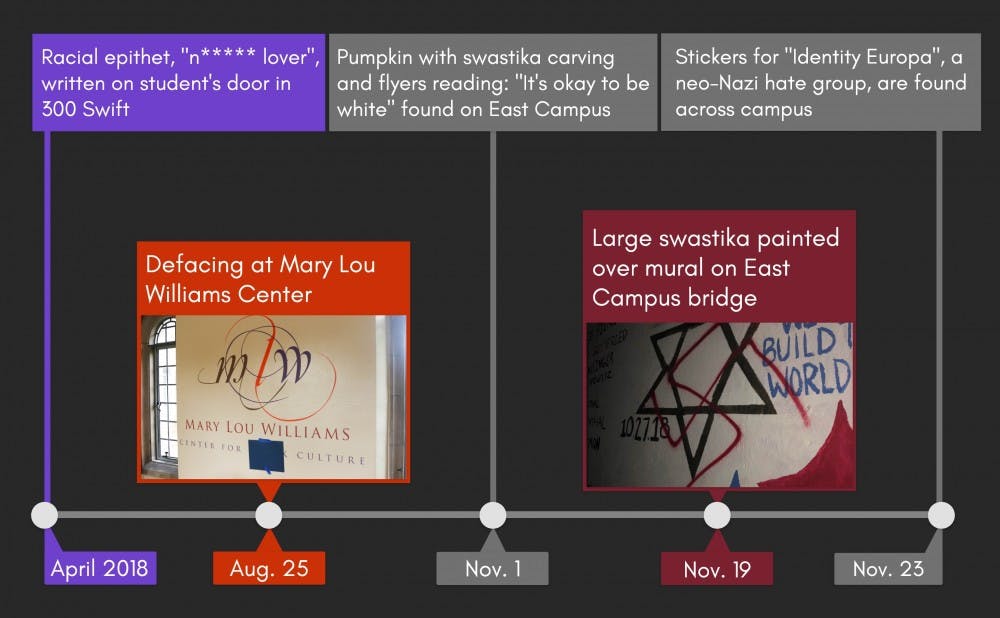As racially charged incidents have occurred on Duke’s campus in recent months, the Southern Poverty Law Center says that colleges across the country are witnessing similar acts.
Last Monday, a mural honoring the victims of the shooting at the Tree of Life Synagogue in Pittsburgh was found defaced with a swastika. On Friday, stickers with the name of a neo-Nazi hate group were found across campus. That week's two incidents add to a growing list of recent occurrences at Duke.
“We’ve noticed an increase in the number of racist, white supremacist propaganda on college campuses over the last school year,” said Lecia Brooks, director of outreach at the Southern Poverty Law Center, in an interview with The Chronicle. "That’s evidenced by flyers and stickers and swastikas—the things that you’ve seen at Duke.”
Brooks pointed out that the Anti-Defamation League reported a 77 percent increase in white supremacist propaganda on U.S. college campuses during the 2017-2018 school year.
“It’s unsettling at best, it’s terrorizing at worst,” Brooks said. “For a lot of students in marginalized groups, it's the first time they’ve been in such integrated space, and they don’t feel safe.”
In January 2018, Carina Carpenter, residence coordinator of Bell Tower Dormitory, sent an email to Bell Tower residents about a black student who said she was passed by two men who said, “F*** you, n******” to her.
"I believe it is important to share the exact words so that you have a fuller understanding of what one of your housemates experienced," Carpenter wrote in the email. "I am deeply disturbed that an incident such as this would happen in our home in Bell Tower. The impact of discriminatory and hateful incidents like this ripple out and affect the entire community."
During the last week of the Spring 2018 semester, two Snapchats made by a Duke student using racial epithet were posted to the memes page, and the racial epithet “n***** lover" was written on a student’s door in the 300 Swift apartments.
On Aug. 25, the word "n*****" was found written over the word “Black” on a wall in the Mary Lou Williams Center for Black Culture.
Chandra Guinn, director of the Mary Lou Williams Center for Black Culture, expressed how the black community is moving forward after these events.
“I remain hopeful that love will win, and the Mary Lou Williams Center for Black Culture will continue to be a beacon of love, life and learning,” Guinn wrote in an email to The Chronicle.
A mural celebrating Latinx Heritage Month was found defaced under the East Campus Bridge Sept. 22. It was covered with black spray paint a day after it was created. A day after the vandalism, a local graffiti artist approached Mi Gente and admitted to the action, telling the group that he was spray-painting a graffiti piece and later realized that he was defacing the mural.
There have also been a series of acts involving swastikas. In mid-October, a swastika was found carved into a bathroom stall in the Languages Building. The day after Halloween, a pumpkin with a swastika carved into it and flyers reading “It’s okay to be white” were found on East Campus. On Nov. 19, a large red swastika was found painted over a mural honoring the victims of the shooting at the Tree of Life Synagogue in Pittsburgh.
Brooks pointed out that three swastikas were recently found at Cornell University, the same number that have received attention at Duke this semester.
On Nov. 23, stickers with “Identity Evropa” written on them were found across campus. The Southern Poverty Law Center identifies Identity Evropa as a White Nationalist group.
Joyce Gordon, director for Jewish Life at Duke, spoke to the hopes of the Jewish community looking forward.
“We, our Duke Jewish community, will continue to move from strength to strength,” Gordon said. “This kind of anti-Semitic action is not representative of Duke, it is not representative of our values, and we our stronger than that, we are stronger than the person who drew the swastika.”
Brooks noted that the increase in acts of hate and bias on college campuses is part of an even larger national trend.
“The Southern Poverty Law Center has noticed a marked increase in the number of hate and bias incidents really since the 2016 presidential campaign,” Brooks said.
Brooks argued the trend is related to the President Donald Trump’s use of demonizing rhetoric that provides cover and permission for others to do the same. She also cited a notion of being released from a sense of political correctness as a factor leading to the emboldening of white supremacists.
Get The Chronicle straight to your inbox
Sign up for our weekly newsletter. Cancel at any time.
She also commended Duke President Vincent Price for his statement in response to the most recent swastika found on campus.
“These acts need to be acknowledged and condemned every time,” she said. “When this first began to happen with the flyering, campus administrators would denounce the flyer and say this doesn’t comply with the values of our university—and that was that. They need to be stronger, to say who these folks are, to say that this is anti-Semitism or white supremacy, or whatever it is, and we condemn it and we stand by all students at our university and we are going to do what we can to root this out.”

